|
Feb
03
2025
|
|
Posted 314 days ago ago by Admin
|
|
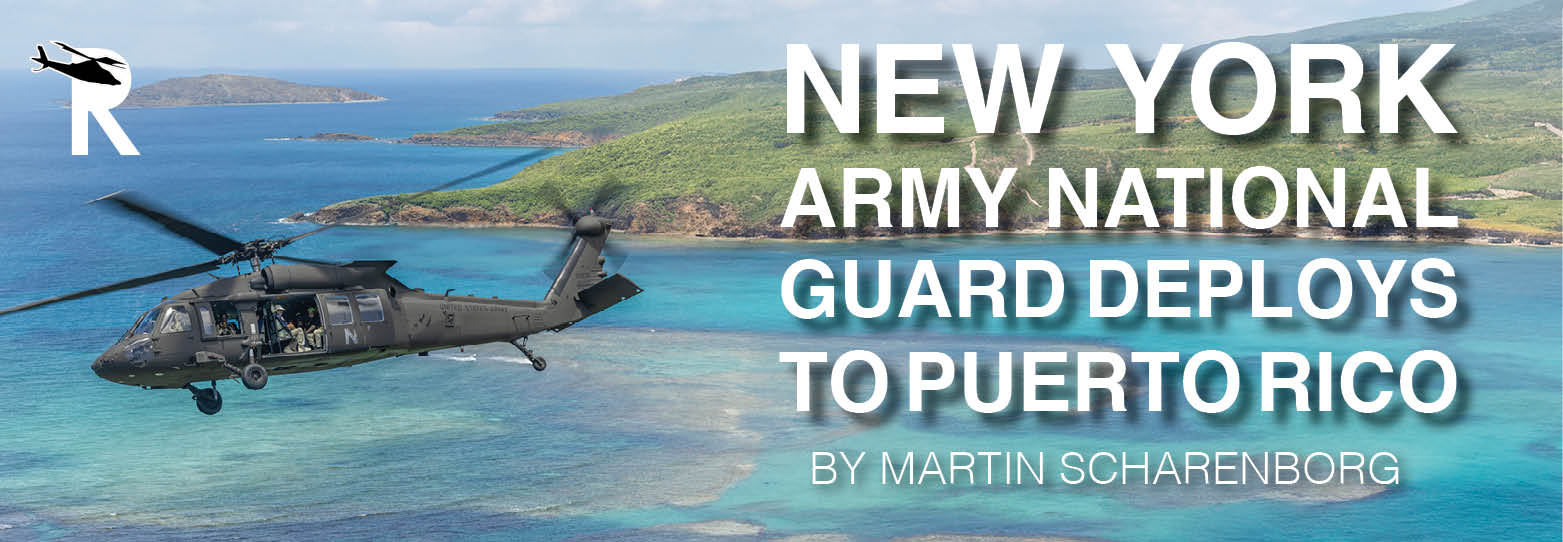
For units of the New York Army National Guard, the year could not have started busier. In early May, Bravo Company of the 3-142nd Assault Helicopter Brigade (B. Co 3-142 AHB) deployed four Sikorsky UH-60M Blackhawk helicopters to Gulfport, Mississippi, to participate in the MARSOC 24-4 exercise. Meanwhile, Alpha Company of the 3-142 Assault Helicopter Brigade (A. Co 3-142 AHB) was deployed with four UH-60M Blackhawk helicopters and 45 personnel to Barbados to take part in the multinational exercise named “Tradewinds 24.” This annual exercise, organized by the U.S. Southern Command (SOUTHCOM), took place from May 4 to May 16 with the participation of 25 countries. The focus during this 39th iteration of the exercise was mainly on improving interoperability and effectively executing both maritime and land operations, but it also dealt with humanitarian assistance and disaster response.
Puerto Rico
Barely back from Barbados, preparations began for the annual brigade-level exercise of the 42nd Combat Aviation Brigade, which also includes the 3-142nd Assault Helicopter Brigade. This year, Puerto Rico was chosen as the exercise location for the 42nd Expeditionary Combat Aviation Brigade. Puerto Rico is located in the Caribbean Sea, about 995 miles from the U.S. mainland, between the U.S. Virgin Islands and the Dominican Republic, and it includes several larger and smaller islands. The Free Associated State of Puerto Rico is considered an organized, incorporated territory of the United States, and therefore, the citizens of Puerto Rico are regarded as U.S. citizens.
Due to its location and status, the island is popular with criminals for smuggling drugs from South American countries such as Venezuela and Colombia to the U.S. mainland. Its proximity to the Dominican Republic and Haiti also attracts crime. Human traffickers regularly attempt to bring refugees from these countries to Puerto Rico.
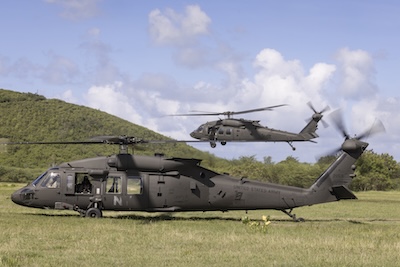
However, the island is unfortunately also known for its often unpredictable and turbulent weather. From the beginning of June through November, the Caribbean is in hurricane season. In recent history, the island has often been hit hard. For example, in September 2017 hurricanes Irma and Maria caused devastating damage. Hurricane Maria was the fiercest storm that hit the entire island since 1928. Winds speeds of up to 155 miles per hour were reached (250 km/h), and flooding happened up to 38 inches (97 centimeters) that caused damage to approximately 1,068,000 homes and there was power loss on the entire island. Around 3.000 people perished as a result of this storm.
Preparations
On 1 June 2024 and the following day, 86 personnel and four helicopters were flown in from Rochester, Albany, and Long Island by Boeing C-17A Globemasters belonging to the 105th Airlift Wing of the New York Air National Guard to San Juan International Airport (SJU)/Muñiz Air National Guard Base. The four helicopters, two UH-60Ms from the 3-142nd Assault Helicopter Brigade and two MEDEVAC UH-60Ls from Charlie Company 1-171st General Support Aviation Battalion (C. Co 1-171 GSAB), nicknamed “Genny Dustoff,” were unloaded on the grounds of the 156th Wing of the Puerto Rico Air National Guard and made ready to depart for their temporary stay at the Joint Training Center Camp Santiago near Salinas on the south of the island, from where the planned missions were executed daily.
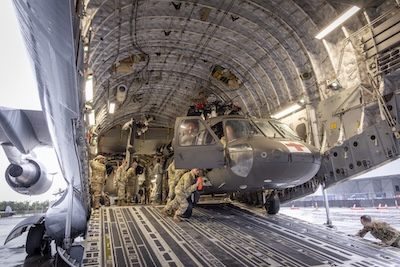
‘Legend Connection’
The 3-142 Assault Helicopter Brigade is no stranger to Puerto Rico. In September 2017, four UH-60 Blackhawk helicopters and 60 personnel were deployed to the island in the aftermath of hurricanes Irma and Maria to assist in evacuating people, transporting aid workers, delivering relief supplies, and to conduct medical evacuation flights from Puerto Rico, the U.S. Virgin Islands, and Saint Maarten.
In the recent deployment named Legend Connection, cooperation with local relief agencies, the military, and law enforcement units were once again central, and several scenarios were developed in the area of humanitarian relief and disaster response in which the helicopters of the 3-142nd AHB and 1-171st GSAB could play a crucial role. In close cooperation with FEMA (Federal Emergency Management Agency), personnel from local urban search and rescue teams, as well as with personnel from the Department of Justice and FURA (an acronym for Joint Forces of Rapid Action), were picked up and transported to a fictitious disaster location and later retrieved. In this case, it involved positioning helicopters from Camp Santiago to San Juan/Isla Grande Airport, where the relief workers were picked up for a flight to the island of Culebra, where they were later retrieved for the flight back to San Juan.
Because Puerto Rico also suffers significantly from illegal human trafficking and a near-constant influx of drugs, a special exercise was set up in cooperation with the CBP-AMO (Customs and Border Patrol - Air and Marine Operations) from Boqueron, near Cabo Rojo. The pilots flown in from the New York Army National Guard received an extensive briefing from the CBP-AMO about the tasks and challenges they face almost daily. This includes intercepting illegal refugees and drug couriers in their often fast boats coming from the Dominican Republic and other Caribbean islands. The CBP-AMO also has fast boats to intercept these couriers. The use of helicopters in these operations is indispensable, and special interception tactics have been developed for this. Communication between boat and helicopter during these tactical maneuvers is key. After an extensive briefing on these interception tactics, UH-60 Blackhawk pilots from the CBP-AMO joined their colleagues from the New York Army National Guard in their UH-60L/Ms. In the bay of Boqueron, a drug interception was staged with an 'enemy' boat and two CBP 41-foot secure-around-flotation-equipped (SAFE) boats. In turn, the New York Army National Guard pilots flew an interception action under the expert guidance of the experienced CBP pilots.
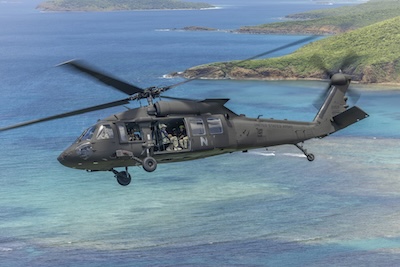
Besides these special exercises, there was also room to conduct personal recovery missions where soldiers were dropped in the rugged and sometimes inhospitable terrain of Puerto Rico. They had to find their way to a designated pick-up point using analog navigation to be flown back to Camp Santiago. Special missions were also conducted for the UH-60L MEDEVAC helicopters and their crews, where patients were brought to Camp Santiago by ambulance and then flown to hospitals across the island. Missions were also conducted in cooperation with the UH-60 Blackhawk helicopters of the Puerto Rico Army National Guard to Borinquen, Puerto Rico, and St. Croix of the U.S. Virgin Islands.
Starting June 10, preparations began for the redeployment to the United States by flying the helicopters back from Camp Santiago to San Juan International Airport to be dismantled for transport by a Boeing C-17A Globemaster.
Valuable lessons learned
Major Daniel T. Collier, 42nd ECAB (Expeditionary Combat Aviation Brigade) operations officer, and an experienced UH-60 Blackhawk pilot with the 3-142 Assault Helicopter Brigade with 1,170 flight hours in his logbook, looks back on this deployment with satisfaction.
He said, “We flew more than 20 flights for a total of 68.4 flight hours in day, night and in night vision goggles (NVG) modes of flight. We flew not only a joint air/marine interdiction familiarization training mission with the Customs and Border Protection Air and Marine units from Puerto Rico, but we also flew missions in support of the FEMA Caribbean office, FEMA Region II, and the Puerto Rico urban search and rescue (USAR) teams. We furthermore conducted personnel recovery training missions with our organic air assets consisting of C.1/-171st Air Ambulance Company (GSAB), and our 3-142nd Assault Helicopter Battalion. We coordinated with, and trained with the Puerto Rico Army National Guard aviation units. We relied heavily upon the 156th Wing from the Puerto Rico Air National Guard for support during our STRAT AIR (Strategic Air transport ) movements, and blade folding/unfolding operations. Our STRAT AIR C-17s were provided by the 105th Airlift Wing of the New York Air National Guard based at Stewart ANGB, and the 172nd Airlift Wing from the Mississippi Air National Guard based at Jackson ANGB”.
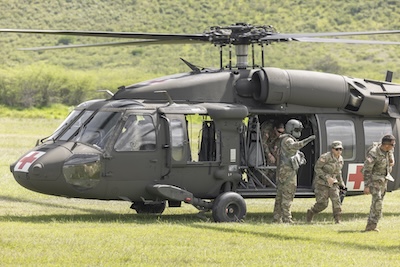
Collier continues: “The most special mission for me however during this annual training, was the air movement of the Puerto Rico USAR teams in conjunction with the Puerto Rico Army National Guard. These mission sets were representative of the support we could provide and cooperation required during an actual disaster response mission that the New York National Guard could be tasked with. The biggest learning moment and challenge for this annual training was the expeditionary deployment of the four Blackhawk helicopters. The time, training, preparation and resources required for the STRAT deployment of the Blackhawk is remarkable. Challenges are presented when you are offloading aircraft in a location where you do not have an organic, logistical footprint. We did thorough coordination and planning prior to the exercise, but there are many things unforeseen and unrealized until arrival. Our blade fold team performed tremendously and ensured that all four Blackhawks were operational prior to the exercise beginning on 5 June 2024. There were many hurdles but the team was trained to overcome and persevere despite grueling heat and constant rain storms.”
The personnel and helicopters left San Juan on 13 June with three C-17As for Albany, Rochester and Long Island, New York.
READ MORE ROTOR PRO: https://justhelicopters.com/Magazine
WATCH ROTOR PRO YOUTUBE CHANNEL: https://buff.ly/3Md0T3y
You can also find us on
Instagram - https://www.instagram.com/rotorpro1
Facebook - https://www.facebook.com/rotorpro1
Twitter - https://twitter.com/justhelicopters
LinkedIn - https://www.linkedin.com/company/rotorpro1